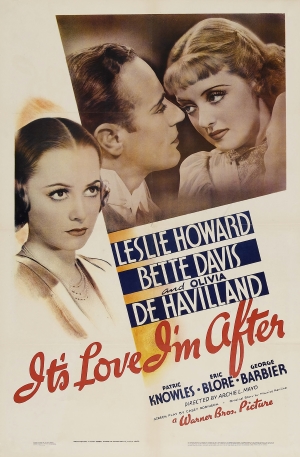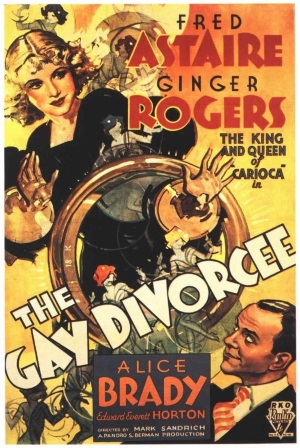
The Taming of the Shrew
It’s Love I’m After draws many parallels to the earlier screwball comedy Twentieth Century (1934) with Leslie’s Howard’s Basil Underwood drawing a number of similarities John Barrymore’s Oscar Jaffe. Basil Underwood is an egomaniacal actor who is as big a ham off stage as he is on. Like Barrymore in Twentieth Century, he can never describe something in a conventional matter but rather has to do it poetically with his constant references to Shakespeare, with Howard’s English accent making him sound all the more pretentious. He’s clearly a man of the theatre to the point that he doesn’t even know who Clark Gable is (yes they actually mention an MGM star in a Warner Bros movie when studios were keen to usually only promote their own contract players). Likewise, his sparing with Bette Davis as his bride to be Joyce Arden is similar to the screaming and shouting between John Barrymore and Carole Lombard in Twentieth Century, yet in a movie with Bette Davis Howard is still the bigger drama queen.
Although Basil is engaged to marry Joyce despite the two hating each other one minute and then are in a loving embrace the next, the real unforgettable dynamic is between Howard and Eric Blore. It’s implied throughout the film that Basil and the effeminate Diggs are gay lovers through much gay subtext (“Do we know anyone called Marsha West Diggs?”, “Not unless you’ve been cheating on me, sir”). This occurs even though Basil is set to marry Joyce, thus is Joyce even aware of this and are they involved in a three-way relationship or is Basil cheating on Joyce with Diggs? Why does Basil even need Joyce if he has the perfect partner in Diggs? Either way, the dynamic between the entire cast of It’s Love I’m After is effortless.
Olivia de Havilland’s Marcia West is an early example of what we would now call fanboyism, having a fanatical love for Basil Underwood. Yet despite her bursts of hyperactivity and her ditzy manner, she does have a smarter side to her. She does cleverly get her way into Underwood’s dressing room at the theatre and even has the common sense to just talk to him about her feelings towards him then run off again and not to continue bothering him. It’s only when Basil deliberately turns up to her house does he feel the full wrath of her fanaticism.
Also contributing to the movie’s over the top histrionics is Bonita Granvillie as the chatterbox Gracie. I actually find her character quite disturbing with her spying through keyholes on other people’s business only to then tell the rest of the family about her discoveries. She reminded me the little girl who from These Three and its remake The Children’s Hour who ruined people’s lives with deceitful spying and her big mouth. Thus it came as no surprise when I learned she was the actress who played the little girl in These Three!
The cinematography of It’s Love I’m After is also a thing beauty, a perfect showcase the distinctive Warner Bros aesthetic of the 30’s and 40’s; particularly the lighting the of the dark theatre at the beginning of the film and those spellbinding close-ups of Miss de Havilland. During the beginning of the film, Basil and Joyce are playing Romeo & Juliet on stage. Howard had played Romeo the year before in MGM’s production of Romeo & Juliet which along with Warner’s A Mid-Summer Night’s Dream in 1935, had failed to garner much interest from filmgoers. I get the impression It’s Love I’m After reflects this when Spring Byington falls asleep to the production of Romeo & Juliet only to be waken and utters “Isn’t it so wonderful, Shakespeare is so elevating”.



